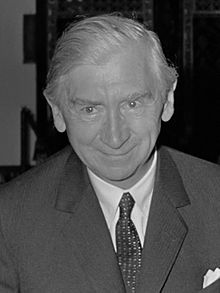Herbert Read
Sir Herbert Edward Read DSO , MC (born December 4, 1893 on the Muscoats estate near Stonegrave ( Yorkshire ), † June 12, 1968 in Stonegrave) was a British poet, writer and philosopher in the field of art . He worked at the Institute of Contemporary Arts (ICA) in London .
Life
Herbert Read was born in Yorkshire to a farming family. He studied arts and literature at the University of Leeds . During the First World War he was a frontline officer in Belgium and France. After his return he quickly found access to the London literary scene, a. a. to TS Eliot and Ezra Pound .
Read then worked as a ministerial official at the Victoria and Albert Museum in London. In the 1930s he established himself as a writer ( The Green Child ) and art historian, living the life of both a scholar and a libertarian intellectual. Artistically, he made a name for himself as a leading connoisseur of surrealism and, together with Roland Penrose , David Gascoyne and others, organized the first major - and later legendary - English surrealism exhibition " International Surrealist Exhibition " in the New Burlington Galleries from June 11th to 1936 on July 4th of the year in London. Herbert Read was editor of the art magazine Burlington Magazine (1933-1939) and the first edition of The Thames and Hudson Dictionary of Arts and Artists (1966). In 1966 he was awarded the Erasmus Prize and was made an honorary member of the American Academy of Arts and Letters .
Read was President of the British Society for Art Education, the Institute of Contemporary Art and the Yorkshire Philosophical Society.
position
Politically, Read came forward with his commitment to anarchism . For him, Max Stirner's work The One and His Own was “a book that I have never lost sight of.” The idea of mutual help as a supporting social category of evolution became for him the maxim of political action and thought based on the Teachings of Kropotkins . Read got involved in the campaign against nuclear armament, including by taking part in street demonstrations. After he accepted the knighthood in 1953 , many of his anarchist companions distanced themselves from him. In his last years he withdrew more and more from the public due to cancer.
Publications
- Wordsworth . Cape, London 1932.
- The Green Child . Heinemann, US 1935. (Text of a later edition: archive.org )
- A Coat of Many Colors. Occasional essays . Routledge, London 1945.
- The Grass Roots of Art . Drummond, cited 1947.
- The root of art . Translated from the English by Friedrich Hundt. Suhrkamp, Berlin / Frankfurt a. M. 1951.
- The art of art criticism . Sigbert Mohn Verlag, Gütersloh 1957.
- Art and society . Forum-Verlag, Vienna / Frankfurt a. M. 1957.
- History of Modern Painting . Droemer Knaur, Munich / Zurich 1959.
- Picture and idea . DuMont, Cologne 1961.
- Education through art . Translated from the English by Alfred P. Zeller . Droemer Knaur, Munich / Zurich 1962.
- Forms of the unknown . Translated by Friedrich Hundt. Rhein-Verlag, Zurich 1963.
- To Hell with Culture . Routledge, London 1963. New edition 2002, ISBN 978-0-415-28993-1 .
- History of Modern Plastic . Droemer Knaur, Munich / Zurich 1966.
- Philosophy of anarchism . AHDE-Verlag, Berlin 1982.
- Art, culture and anarchy. Political essays against the zeitgeist . Edited by Ulrich Klemm. Nevertheless publisher, Grafenau-Döffingen 1991, ISBN 3-922209-36-X
Web links
- Literature by and about Herbert Read in the catalog of the German National Library
- Works by and about Herbert Read in the German Digital Library
Individual evidence
- ^ DTV Lexicon: Lemma Herbert Read. Munich 2006.
- ↑ When the Critic Creates: A Review of Herbert Read's The Green Child --- Tom Faure | Numéro Cinq . In: Numéro Cinq . January 1, 2014 ( numerocinqmagazine.com [accessed October 22, 2018]).
- ^ Honorary Members: Herbert Read. American Academy of Arts and Letters, accessed March 19, 2019 .
- ^ Herbert Read: Max Stirner. In: ders .: The art of art criticism and other essays on philosophy. Gütersloh: Sigbert Mohn 1960, pp. 87–94 (88)
| personal data | |
|---|---|
| SURNAME | Read, Herbert |
| ALTERNATIVE NAMES | Sir Read, Herbert Edward |
| BRIEF DESCRIPTION | British art historian |
| DATE OF BIRTH | 4th December 1893 |
| PLACE OF BIRTH | Stonegrave , Well Muscoats, Yorkshire |
| DATE OF DEATH | June 12, 1968 |
| Place of death | Stonegrave |
